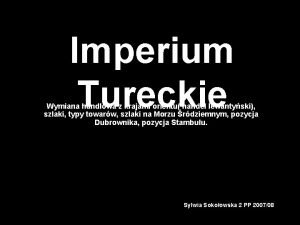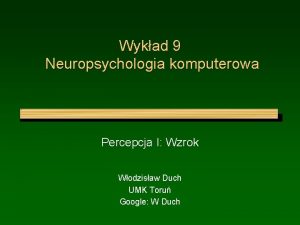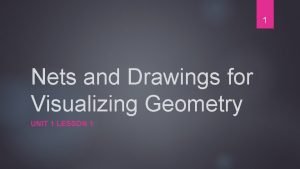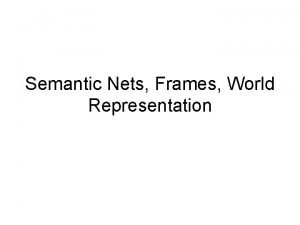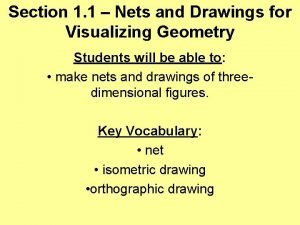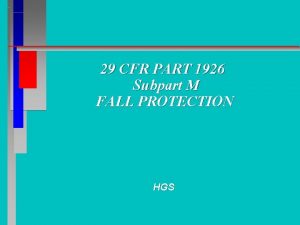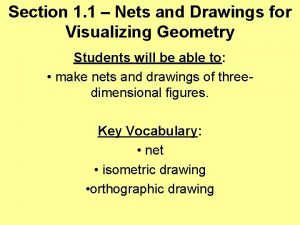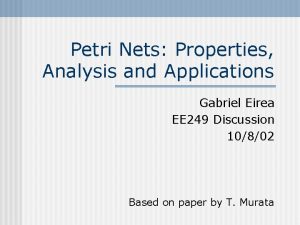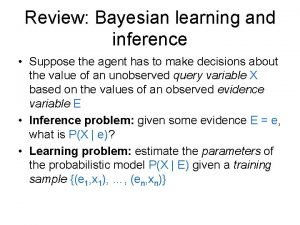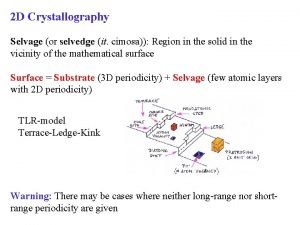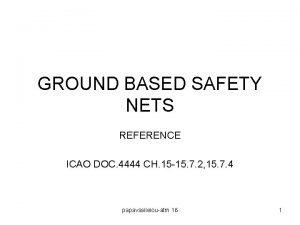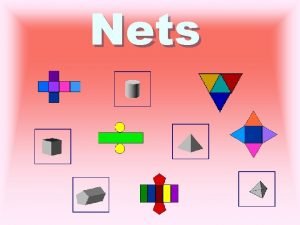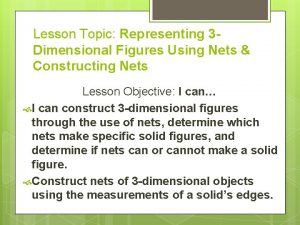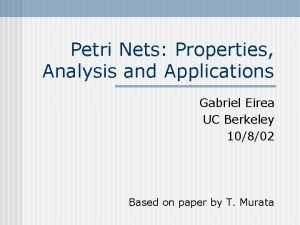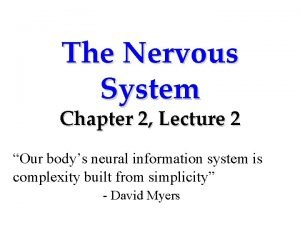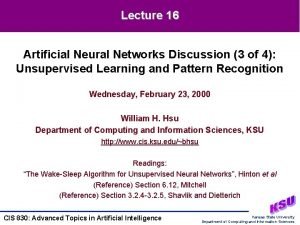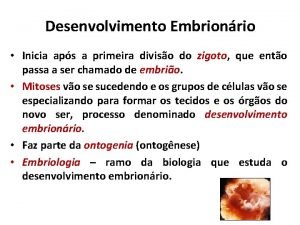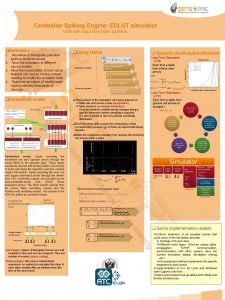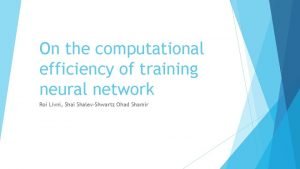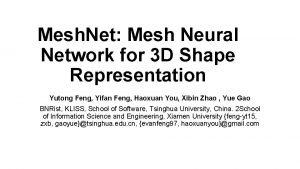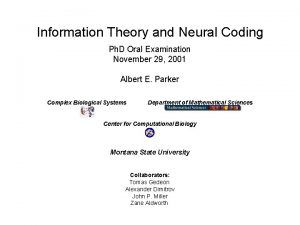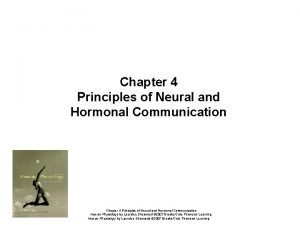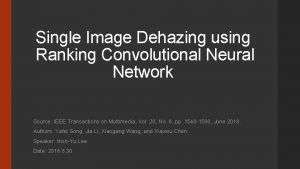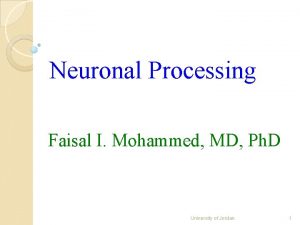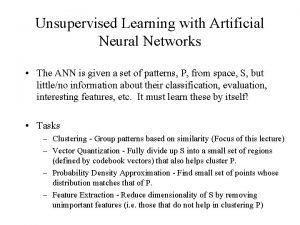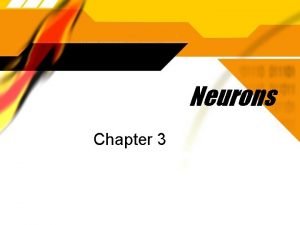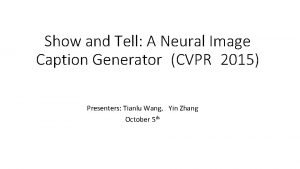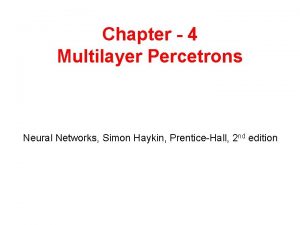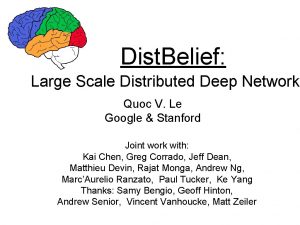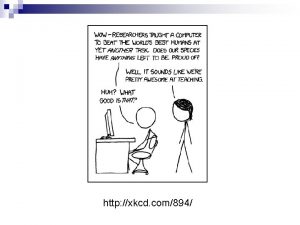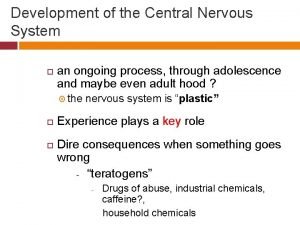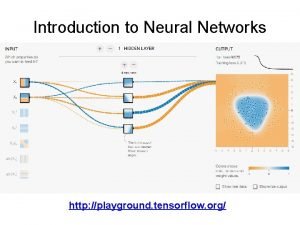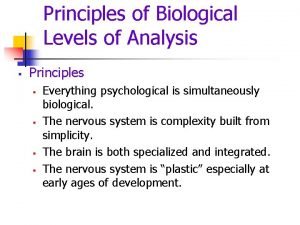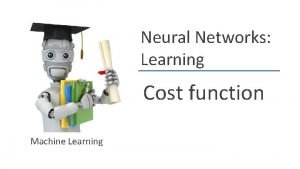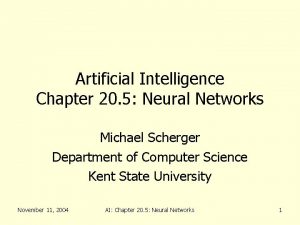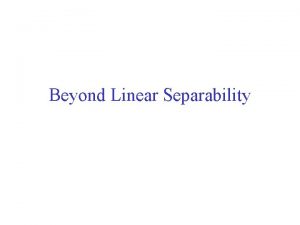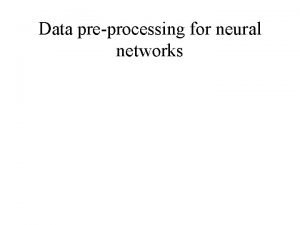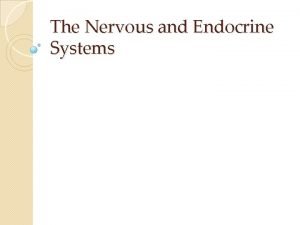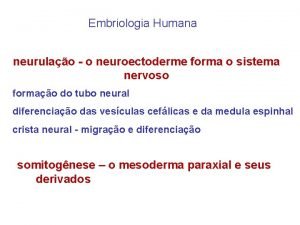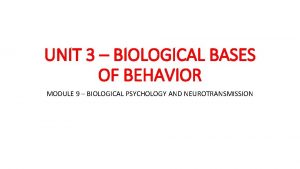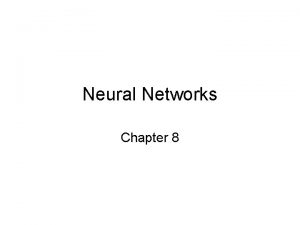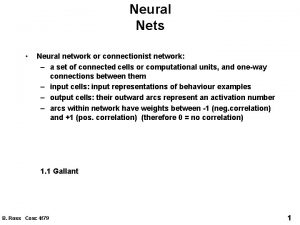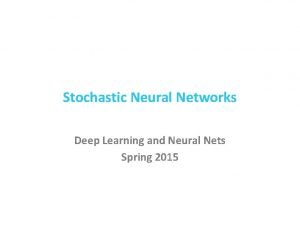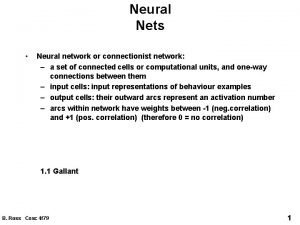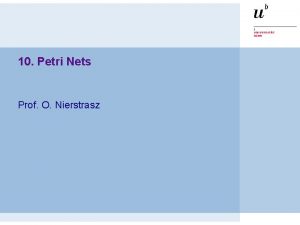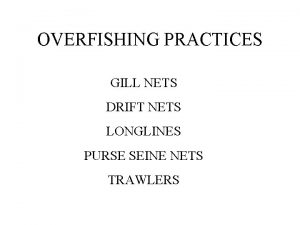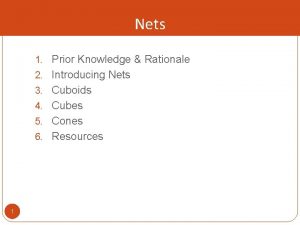VC Dimension of Neural Nets Liran Szlak Shira


















































































- Slides: 82

VC Dimension of Neural Nets Liran Szlak & Shira Kritchman

Outline • VC dimension & Sample Complexity • VC dimension & Generalization • VC dimension in neural nets • Fat-shattering – for real valued neural nets • Experiments

Part I: VC Dimension Theory

Motivation •

Motivation • What property makes a learning model good? • Can we learn from a finite sample? • How many examples do we need to be good? • How to choose a good model?

Hypothesis Class • An hypothesis class H is a set of models b

Neural Nets Hypothesis Class

VC Dimension – Shattering •

VC Dimension – Shattering •

VC Dimension – Shattering •

VC Dimension – Shattering •

VC Dimension – Shattering •

VC Dimension – Shattering •

VC Dimension – Shattering •

VC Dimension – Shattering •

VC Dimension – Definition • Vapnik & Chervonenkis, 1971

VC Dimension – Open Intervals •

VC Dimension – Open Intervals •

VC Dimension – Convex Sets •

VC Dimension – Convex Sets •

VC Dimension – Convex Sets •

• We saw we can shatter 3 points before

• We saw we can shatter 3 points before • No set of 4 points can be shattered

• We saw we can shatter 3 points before • No set of 4 points can be shattered





Reminder! • What property makes a learning model good? • Can we learn from a finite sample? • How many examples do we need to be good? • How to choose a good model? VC Dimension Sample Complexity Generalization

What Is a Good Model? • x y h i. i. d

What Is a Good Model? PAC Probably Approximately Correct Intuition: We want to be close to the right function with high probability

What Is a Good Model? H

What Is a Good Model? Backpropagation Algorithm A H

What Is a Good Model? Backpropagation Algorithm A H

What Is a Good Model? Backpropagation Algorithm A H

What Is a Good Model? • PAC learnable H • Distribution free guarantee • Overly pessimistic…? . . . • Other measures of “goodness” might be relevant • How does the VC-dimension relate to PAC learnability? How expressive is H? Can we approximate any D with H, using a finite training set?

VC Dimension and PAC Learnability •

VC Dimension & Learning Guarantees Vapnik & Chervonenkis, 1971

VC Dimension & Learning Guarantees

Sauer’s Lemma • H

Sauer’s Lemma • H

Sauer’s Lemma • H

Sauer’s Lemma • The number of different labeling strings that H can achieve on the set H

Sauer’s Lemma • Vapnik & Chervonenkis, 1971 Sauer, 1972 Shelah, 1972

Recap! VC(H)

Recap! VC(H)

Recap! VC(H)

Recap! VC(H)

Recap! • What property makes a learning model good? • Can we learn from a finite sample? • How many examples do we need to be good? • How to choose a good model?

VC Dimension of NN •

VC-Dimension of NN Hypothesis Class VC-dim linear parameterization with n parameters (i. e. perceptron) single hidden layer with fixed input weights single hidden layer with fixed output weights multilayer neural net with binary activations and p weights multilayer neural net with binary / linear activations and p weights piecewise polynomial activations, Deg<=D, <=p pieces Sigmoid activation with p parameters

Other Dimensions •

Fat Shattering •

Fat Shattering •

Fat Shattering •

VC-dimension and PAC Learning Approach to NN – Caveats VC-bound learning guarantee: • Too strict • Any distribution D • Any function h • Not tight • Only a bound • Computing the VC-dimension • One shattered set is enough

Part II: Empirical Tests

Experiments’ Motivation •

Experiments’ Methodology H D Hypothesis Class f Distribution n examples (x, y) A Algorithm f

Experiments Toy Example – Regression Training Test ? H Hypothesis Class

Randomization Tests Methodology Multi-label classification problems with standard successful architectures bird Randomization test: train on random labels Expected test error: tree approximate on a validation set Expected training error:

Randomization Tests Methodology Data CIFAR 10, with 10 categories (Russakovsky et al. , 2015) Image. Net, with 1000 categories (Krizhevsky & Hinton, 2009)

Randomization Tests Methodology Data CIFAR 10, with 10 categories (Russakovsky et al. , 2015) Image. Net, with 1000 categories (Krizhevsky & Hinton, 2009) Architectures - MLP (Multi-Layer Perceptron) - Alex. Net (Krizhevsky et al. , 2012) - Incecption V 3 (Szegedy et al. , 2016)

Randomization Tests Methodology Data CIFAR 10, with 10 categories (Russakovsky et al. , 2015) Image. Net, with 1000 categories (Krizhevsky & Hinton, 2009) Architectures - MLP (Multi-Layer Perceptron) - Alex. Net (Krizhevsky et al. , 2012) - Incecption V 3 (Szegedy et al. , 2016) Data manipulation - True labels - Random labels - Shuffled pixels - Random pixels - Gaussian bird tree Algorithm manipulation - Dropout - Data augmentation Generalization techniques: - Weight decay standard tools to confine - Early stopping our learning and encourage - Batch normalization generalization

Randomization Tests Methodology Multi-label classification problems with standard successful architectures Randomization test: train on random labels Expected test error: - CIFAR 10 (10 categories): 90% - Image. Net (1000 categories): 99. 9% Expected training error: approximate on a validation set

Randomization Tests Results (CIFAR 10) Empirical training error: 0 “Deep neural networks easily fit random labels” “by randomizing labels alone we can force the generalization error of a model to jump up considerably without changing the model, its size, hyperparameters, or the optimizer” (Inception)

Randomization Tests Implications Recall VC bound generalization guarantee: large 0 large low on real labels The network’s capacity is high enough to memorize the entire dataset VC-dim is high VC-dim doesn’t explain the good generalization!

Randomization Tests Results (CIFAR 10) Empirical training error: 0 “Deep neural networks easily fit random labels” (Inception)

Randomization Tests Results (CIFAR 10) “Explicit regularization may improve generalization performance, but is neither necessary nor by itself sufficient for controlling generalization error” Huge unexplained gap!

Randomization Tests Results (Image. Net) “Explicit regularization may improve generalization performance, but is neither necessary nor by itself sufficient for controlling generalization error”

Randomization Tests Results “Explicit regularization may improve generalization performance, but is neither necessary nor by itself sufficient for controlling generalization error”

Randomization Tests Implications Recall VC bound generalization guarantee: large low on real labels 0 large even without regularization techniques The network’s capacity is high enough to memorize the entire dataset VC-dim is high VC-dim doesn’t explain the good generalization! Regularization techniques don’t explain it either!

Finite Sample Expressivity Input - d dimensions (e. g. # of pixels) - n samples Theorem: there exist a network with 2 n+d weights that can represent any function on any sample Network - Two layers (but wide) - or k layers each with O(n/k) parameters - Re. LU activation - P = 2 n + d parameters

Finite Sample Expressivity – Proof 1. Can be expressed by a depth 2 NN with Re. LU activations 2. Can memorize any input

Finite Sample Expressivity – Proof •

Finite Sample Expressivity – Proof •

Finite Sample Expressivity Input - d dimensions (e. g. # of pixels) - n samples Theorem: there exist a network with 2 n+d weights that can represent any function on any sample Network - Two layers (but wide) - or k layers each with O(n/k) parameters - Re. LU activation - P = 2 n + d parameters

Experiments’ Methodology ? D Hypothesis Class f Distribution n examples (x, y) H A Algorithm f

SGD as an Implicit Regularizer •

SGD as an Implicit Regularizer •

Summary Theory - Shattering and VC-dim - PAC learning - VC-dim implications on generalization and sample complexity - Sauer’s Lemma - Bounds for VC-dim of NN - Fat shattering dimension Experiments - Randomization tests: 0% training error - Explicit regularizers: can generalize without - Finite sample expressivity - SGD as implicit regularizer - Still don’t know the reason for good generalization!

THE END
 Vc bound
Vc bound Shira be tsibur
Shira be tsibur Teaching english to arabic speakers
Teaching english to arabic speakers Idolity
Idolity Handel lewantyjski
Handel lewantyjski Strumień brzuszny i grzbietowy
Strumień brzuszny i grzbietowy Szlak poliketydowy
Szlak poliketydowy Compostelka
Compostelka Bobrowy szlak rzepin
Bobrowy szlak rzepin Diauksja
Diauksja Szlak sorbitolowy
Szlak sorbitolowy Szlak polichromii brzeskich
Szlak polichromii brzeskich Szlak brzuszny i grzbietowy
Szlak brzuszny i grzbietowy Lesson 1 nets and drawings for visualizing geometry
Lesson 1 nets and drawings for visualizing geometry Surface area using nets
Surface area using nets Nets blox
Nets blox What is a priori knowledge
What is a priori knowledge Nets church planting
Nets church planting Semantic nets and frames
Semantic nets and frames Nets and drawings for visualizing geometry
Nets and drawings for visualizing geometry Safety nets must be drop tested
Safety nets must be drop tested Apple sweatshop
Apple sweatshop List the 4 nets for better internet searching
List the 4 nets for better internet searching Nets and drawings for visualizing geometry
Nets and drawings for visualizing geometry Petri nets properties analysis and applications
Petri nets properties analysis and applications Bayes nets
Bayes nets Better convenience
Better convenience Bravais nets
Bravais nets Hlf icao
Hlf icao Partitioned semantic network in artificial intelligence
Partitioned semantic network in artificial intelligence Cylinder net
Cylinder net Nets of square pyramid
Nets of square pyramid Represent solid figures using nets
Represent solid figures using nets Gabriel y petri
Gabriel y petri Ans
Ans The wake-sleep algorithm for unsupervised neural networks
The wake-sleep algorithm for unsupervised neural networks S1iisp36/s344crediamigo/inicial/geral/inicial
S1iisp36/s344crediamigo/inicial/geral/inicial Neural groove
Neural groove Alternatives to convolutional neural networks
Alternatives to convolutional neural networks Edlut
Edlut On the computational efficiency of training neural networks
On the computational efficiency of training neural networks Meshnet: mesh neural network for 3d shape representation
Meshnet: mesh neural network for 3d shape representation Information theory and neural coding
Information theory and neural coding Neural networks and fuzzy logic
Neural networks and fuzzy logic Neural and hormonal communication
Neural and hormonal communication Convolutional neural network
Convolutional neural network Neural circuits the organization of neuronal pools
Neural circuits the organization of neuronal pools Ann unsupervised learning
Ann unsupervised learning Two almond shaped neural clusters
Two almond shaped neural clusters Show and tell a neural image caption generator
Show and tell a neural image caption generator Predicting nba games using neural networks
Predicting nba games using neural networks Thomson learning
Thomson learning Artificial neural network in data mining
Artificial neural network in data mining Xor problem
Xor problem Plexus brachialis
Plexus brachialis Neural control of breathing
Neural control of breathing Large scale distributed deep networks
Large scale distributed deep networks Nerves are neural cables containing many
Nerves are neural cables containing many Intercellular connections
Intercellular connections Xkcd neural network
Xkcd neural network Neural network in data mining
Neural network in data mining Convolutional neural networks for visual recognition
Convolutional neural networks for visual recognition Neural groove
Neural groove Playground tensorflow.org
Playground tensorflow.org Refractory period neuron
Refractory period neuron Backpropagation andrew ng
Backpropagation andrew ng Tacotron 2
Tacotron 2 Neural net
Neural net Audio super resolution using neural networks
Audio super resolution using neural networks Andrew ng rnn
Andrew ng rnn Phases of neural communication like a toilet
Phases of neural communication like a toilet Decision boundary of neural network
Decision boundary of neural network Linear separability in neural network
Linear separability in neural network Neural network data preprocessing
Neural network data preprocessing Visualizing and understanding convolutional networks
Visualizing and understanding convolutional networks Fig 19
Fig 19 Neural crest
Neural crest Nerves are neural cables containing many
Nerves are neural cables containing many Deep forest: towards an alternative to deep neural networks
Deep forest: towards an alternative to deep neural networks Placa neural
Placa neural Neural impulse like a toilet
Neural impulse like a toilet Audio super resolution
Audio super resolution Feedforward neural
Feedforward neural




